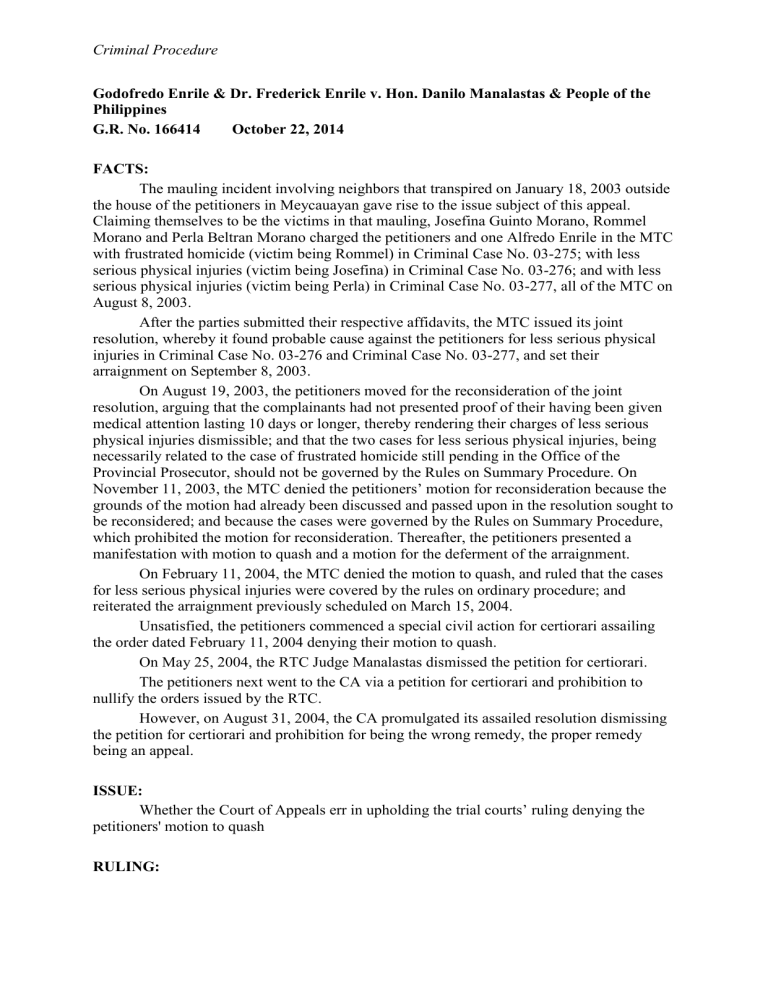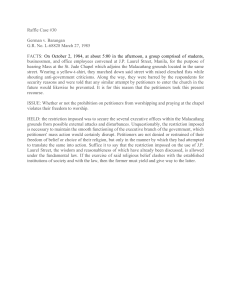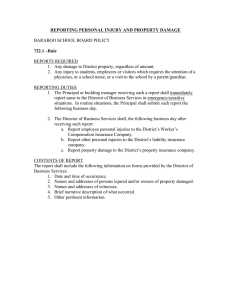
Criminal Procedure Godofredo Enrile & Dr. Frederick Enrile v. Hon. Danilo Manalastas & People of the Philippines G.R. No. 166414 October 22, 2014 FACTS: The mauling incident involving neighbors that transpired on January 18, 2003 outside the house of the petitioners in Meycauayan gave rise to the issue subject of this appeal. Claiming themselves to be the victims in that mauling, Josefina Guinto Morano, Rommel Morano and Perla Beltran Morano charged the petitioners and one Alfredo Enrile in the MTC with frustrated homicide (victim being Rommel) in Criminal Case No. 03-275; with less serious physical injuries (victim being Josefina) in Criminal Case No. 03-276; and with less serious physical injuries (victim being Perla) in Criminal Case No. 03-277, all of the MTC on August 8, 2003. After the parties submitted their respective affidavits, the MTC issued its joint resolution, whereby it found probable cause against the petitioners for less serious physical injuries in Criminal Case No. 03-276 and Criminal Case No. 03-277, and set their arraignment on September 8, 2003. On August 19, 2003, the petitioners moved for the reconsideration of the joint resolution, arguing that the complainants had not presented proof of their having been given medical attention lasting 10 days or longer, thereby rendering their charges of less serious physical injuries dismissible; and that the two cases for less serious physical injuries, being necessarily related to the case of frustrated homicide still pending in the Office of the Provincial Prosecutor, should not be governed by the Rules on Summary Procedure. On November 11, 2003, the MTC denied the petitioners’ motion for reconsideration because the grounds of the motion had already been discussed and passed upon in the resolution sought to be reconsidered; and because the cases were governed by the Rules on Summary Procedure, which prohibited the motion for reconsideration. Thereafter, the petitioners presented a manifestation with motion to quash and a motion for the deferment of the arraignment. On February 11, 2004, the MTC denied the motion to quash, and ruled that the cases for less serious physical injuries were covered by the rules on ordinary procedure; and reiterated the arraignment previously scheduled on March 15, 2004. Unsatisfied, the petitioners commenced a special civil action for certiorari assailing the order dated February 11, 2004 denying their motion to quash. On May 25, 2004, the RTC Judge Manalastas dismissed the petition for certiorari. The petitioners next went to the CA via a petition for certiorari and prohibition to nullify the orders issued by the RTC. However, on August 31, 2004, the CA promulgated its assailed resolution dismissing the petition for certiorari and prohibition for being the wrong remedy, the proper remedy being an appeal. ISSUE: Whether the Court of Appeals err in upholding the trial courts’ ruling denying the petitioners' motion to quash RULING: Criminal Procedure NO. The motion to quash is the mode by which an accused, before entering his plea, challenges the complaint or information for insufficiency on its face in point of law, or for defects apparent on its face. Section 3, Rule 117 of the Rules of Court enumerates the grounds for the quashal of the complaint or information, as follows: (a) the facts charged do not constitute an offense; (b) the court trying the case has no jurisdiction over the offense charged; (c) the court trying the case has no jurisdiction over the person of the accused; (d) the officer who filed the information had no authority to do so; (e) the complaint or information does not conform substantially to the prescribed form; (f) more than one offense is charged except when a single punishment for various offenses is prescribed by law; (g) the criminal action or liability has been extinguished; (h) the complaint or information contains averments which, if true, would constitute a legal excuse or justification; and (i) the accused has been previously convicted or acquitted of the offense charged, or the case against him was dismissed or otherwise terminated without his express consent. According to Section 6, Rule 110 of the Rules of Court, the complaint or information is sufficient if it states the names of the accused; the designation of the offense given by the statute; the acts or omissions complained of as constituting the offense; the name of the offended party; the approximate date of the commission of the offense; and the place where the offense was committed. The fundamental test in determining the sufficiency of the averments in a complaint or information is, therefore, whether the facts alleged therein, if hypothetically admitted, constitute the elements of the offense. By alleging in their motion to quash that both complaints should be dismissed for lack of one of the essential elements of less serious physical injuries, the petitioners were averring that the facts charged did not constitute offenses. To meet the test of sufficiency, therefore, it is necessary to refer to the law defining the offense charged, which, in this case, is Article 265 of the Revised Penal Code, which pertinently states: Article 265. Less serious physical injuries– Any person who shall inflict upon another physical injuries x x x which shall incapacitate the offended party for labor for ten days or more, or shall require medical assistance for the same period, shall be guilty of less serious physical injuries and shall suffer the penalty of arresto mayor. Based on the law, the elements of the crime of less serious physical injuries are, namely: (1) that the offender inflicted physical injuries upon another; and (2) that the physical injuries inflicted either incapacitated the victim for labor for 10 days or more, or the injuries required medical assistance for more than 10 days. Were the elements of the crime sufficiently averred in the complaints? The complaints bear out that the elements of less serious physical injuries were specifically averred therein. The complaint in Criminal Case No. 03-276 stated that: (a) the petitioners "wilfully, unlawfully and feloniously attack, assault and strike the face of one JOSEFINA GUINTO MORAÑO;" and (b) the petitioners inflicted physical injuries upon the complainant "that will require a period of 10 to 12 days barring healing and will incapacitate his customary labor for the same period of time;" while that in Criminal Case No. 03-277 alleged that: (a) the petitioners "wilfully, unlawfully and feloniously attack, assault and right and give hitting her head against pavement of one PERLA BELTRAN MORAÑO;" and (b) the petitioners inflicted upon the complainant "physical injuries that will require Medical Attendance for a period of 12 to 15 days barring unforeseen complication." In the context of Section 6, Rule 110 of the Rules of Court, the complaints sufficiently charged the petitioners with less serious physical injuries. Indeed, the complaints only needed to aver the ultimate facts constituting the offense, not the details of why and how the illegal acts allegedly amounted to undue injury or damage, for such matters, being evidentiary, were appropriate for the trial. Hence, the complaints were not quashable. Criminal Procedure In challenging the sufficiency of the complaints, the petitioners insist that the "complaints do not provide any evidence/s that would tend to establish and to show that the medical attendance rendered on private complainants actually and in fact lasted for a period exceeding ten (10) days;" and the medical certificates attached merely stated that "the probable disability period of healing is 10 to 12 days, for Josefina G. Morano, and, 12-15 days, for Perla B. Morano, hence, the findings of the healing periods were merely speculations, surmises and conjectures ."They insist that the "private complainants should have presented medical certificates that would show the number of days rendered for medication considering that they filed their complaint on March 15, 2003 or about two (2) months after the alleged incident." The petitioners’ insistence is utterly bereft of merit. As the MTC and RTC rightly held, the presentation of the medical certificates to prove the duration of the victims’ need for medical attendance or of their incapacity should take place only at the trial, not before or during the preliminary investigation. According to Cinco v. Sandiganbayan, the preliminary investigation, which is the occasion for the submission of the parties’ respective affidavits, counter-affidavits and evidence to buttress their separate allegations, is merely inquisitorial, and is often the only means of discovering whether a person may be reasonably charged with a crime, to enable the prosecutor to prepare the information. It is not yet a trial on the merits, for its only purpose is to determine whether a crime has been committed and whether there is probable cause to believe that the accused is guilty thereof. The scope of the investigation does not approximate that of a trial before the court; hence, what is required is only that the evidence be sufficient to establish probable causethat the accused committed the crime charged, not that all reasonable doubtof the guilt of the accused be removed. We further agree with the RTC’s observation that "the issues raised in the motion to quash are matters of defense that could only be threshed out in a full blown trial on the merits. Indeed, proof of actual healing period of the alleged injuries of the private complainant could only be established in the trial of the cases filed against herein petitioners by means of competent evidence, and to grant the main prayer of the instant petition for the dismissal of the criminal cases against them for less serious physical injuries is to prevent the trial court to hear and receive evidence in connection with said cases and to render judgments thereon. All things considered, it would be premature to dismiss the subject criminal cases filed against the herein petitioners when the basis thereof could be determined only after trial of the merits."

